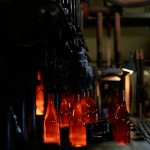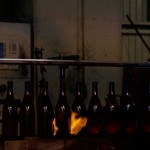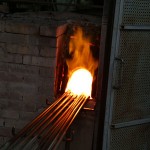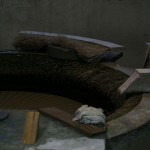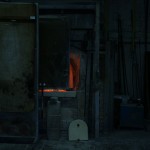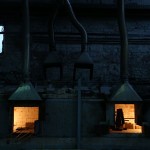Report by Noemi Niederhauser, MA Fine Art Central Saint Martins
In 2015, internationally acclaimed artist, UAL Chair of Art for the Environment Professor Lucy Orta launched the Art for the Environment Residency Programme, in partnership with residency programmes across Europe. Applicants can choose from a two to four week period at one of the hosting institutions, to explore concerns that define the twenty-first century – biodiversity, environmental sustainability, social economy, human rights – and through their artistic practice, envision a world of tomorrow.
Within the 2015 programme was the exciting opportunity to work alongside the glass maestros at the Fondazione Berengo Murano, Venice and the postgraduate student selected for the residency was CSM’s MA Fine Art student Noemi Niederhauser. Here we share Noemi’s report on her experience of the residency.
BRIEF OF THE INITIAL PROJECT: THE GLASS JOURNEY:
The project, in partnership with UAL and the Berengo studio aims to amplify the idea of cycles through which every man-made created object and element goes, a continuous process of: transformation/transition/dissolution/evolution. Through glass objects and a video piece, it will trace the journey, history and ecology of glass as a material from sand to manufactured objects and back again into a recycling process. A sublimation of man’s ability to create and an interrogation of a future for it.
The project is meant to develop in two-folds:
- Some glass sculptural elements that carry traces of both industrial and manual manipulations in their final shapes. Industrial bottles being re-blown manually by a glass-blower in Murano.
- A video piece that traces the process behind the making of glass in a nonlinear chronology. The video will be composed in a braided structure, interweaving different sources and document/archives all of which are linked to human strategies of using glass as a material. An idea of time going in circle/cycle will emerge.
REALIZATION OF THE PROJECT:
Step I:
While planning THE GLASS JOURNEY project, I have been able to get into contact with an industrial glass bottles factory in Switzerland (Vetropack SA) that kindly opened its doors for me to document the whole process of industrial glass making. It allowed me to follow every steps from recycled bottles, to them being turn into sand before to go back into kilns and become bottles again. This opportunity unfold a new direction in the project and re-enforced its concept and relevance.
I am very pleased that this factory, Vetropack SA, St-Prex (Switzerland) is willing to share the final result of the project by organizing an exhibition in its wall. (to be followed)
Step II:
The Berengo Studio in Murano, Venice:
The Berengo Studio in Murano is home to several of the most renowned and skilled glass-blowers of the island. They pass their knowledge from generation to generation in order to obtain results that are highly remarkable. As much as I was excited to be able to develop my own pieces together with them, I was extremely thankful to have the opportunity to simply watch them working.
The whole process and different steps involved, often with several glass technicians working together on one same piece is mesmerizing.
I had the feeling of observing a choreography that has been rehearsed and repeated so many times that the glass-blowers often communicated only through looks and small gestures. I spent my time there watching them working and documenting the whole process. Some sound recording are also part of the traces I gathered and that will be at the core of my video piece.
My project seemed to bear some challenge for the glass-blowers as industrial glass and Murano glass are not totally compatible.
Nevertheless, after few trial and error, the glass-blower managed to find the right adjustment to have an interesting result and be able to re-blow industrial bottles through a manual way. The final glass pieces keep traces of an industrial and a manual process all at once.
They strongly carry the notion of transformation and evolution which is at the core of my project.
Step III (to be done):
I am now waiting to receive the glass pieces to be sent from Murano to Switzerland and I will be able to finish them by complementing them with a metal structure recalling the kiln in which they were done.
At the same time, I will start to edit the video piece with all the footage I gathered along the whole process.
The final result of this residency will be ready around summer 2016.
CONCLUSION:
I can confirm that my fascination with materials and their process of transformation has not been disappointed. On the contrary, leading this project made me understand that my curiosity about this subject keeps on growing. Thus, aside from being able to lead such an interesting project involving different places and ways of working, it also allowed my personal practice to be pushed into new direction which I am eager to pursue.
Noemi Niederhauser, February 2016



